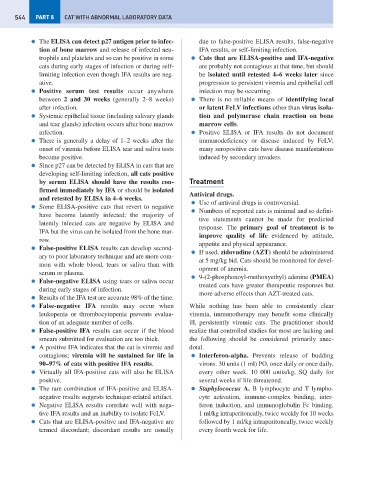Page 552 - Problem-Based Feline Medicine
P. 552
544 PART 8 CAT WITH ABNORMAL LABORATORY DATA
● The ELISA can detect p27 antigen prior to infec- due to false-positive ELISA results, false-negative
tion of bone marrow and release of infected neu- IFA results, or self-limiting infection.
trophils and platelets and so can be positive in some ● Cats that are ELISA-positive and IFA-negative
cats during early stages of infection or during self- are probably not contagious at that time, but should
limiting infection even though IFA results are neg- be isolated until retested 4–6 weeks later since
ative. progression to persistent viremia and epithelial cell
● Positive serum test results occur anywhere infection may be occurring.
between 2 and 30 weeks (generally 2–8 weeks) ● There is no reliable means of identifying local
after infection. or latent FeLV infections other than virus isola-
● Systemic epithelial tissue (including salivary glands tion and polymerase chain reaction on bone
and tear glands) infection occurs after bone marrow marrow cells.
infection. ● Positive ELISA or IFA results do not document
● There is generally a delay of 1–2 weeks after the immunodeficiency or disease induced by FeLV;
onset of viremia before ELISA tear and saliva tests many seropositive cats have disease manifestations
become positive. induced by secondary invaders.
● Since p27 can be detected by ELISA in cats that are
developing self-limiting infection, all cats positive
by serum ELISA should have the results con- Treatment
firmed immediately by IFA or should be isolated
Antiviral drugs.
and retested by ELISA in 4–6 weeks.
● Use of antiviral drugs is controversial.
● Some ELISA-positive cats that revert to negative
● Numbers of reported cats is minimal and so defini-
have become latently infected; the majority of
tive statements cannot be made for predicted
latently infected cats are negative by ELISA and
response. The primary goal of treatment is to
IFA but the virus can be isolated from the bone mar-
improve quality of life evidenced by attitude,
row.
appetite and physical appearance.
● False-positive ELISA results can develop second-
● If used, zidovudine (AZT) should be administered
ary to poor laboratory technique and are more com-
at 5 mg/kg bid. Cats should be monitored for devel-
mon with whole blood, tears or saliva than with
opment of anemia.
serum or plasma.
● 9-(2-phosphonoyl-methoxyethyl) adenine (PMEA)
● False-negative ELISA using tears or saliva occur
treated cats have greater therapeutic responses but
during early stages of infection.
more adverse effects than AZT-treated cats.
● Results of the IFA test are accurate 98% of the time.
● False-negative IFA results may occur when While nothing has been able to consistently clear
leukopenia or thrombocytopenia prevents evalua- viremia, immunotherapy may benefit some clinically
tion of an adequate number of cells. ill, persistently viremic cats. The practitioner should
● False-positive IFA results can occur if the blood realize that controlled studies for most are lacking and
smears submitted for evaluation are too thick. the following should be considered primarily anec-
● A positive IFA indicates that the cat is viremic and dotal.
contagious; viremia will be sustained for life in ● Interferon-alpha. Prevents release of budding
90–97% of cats with positive IFA results. virons. 30 units (1 ml) PO, once daily or once daily,
● Virtually all IFA-positive cats will also be ELISA every other week. 10 000 units/kg, SQ daily for
positive. several weeks if life threatened.
● The rare combination of IFA-positive and ELISA- ● Staphylococcus A. B lymphocyte and T lympho-
negative results suggests technique-related artifact. cyte activation, immune-complex binding, inter-
● Negative ELISA results correlate well with nega- feron induction, and immunoglobulin Fc binding.
tive IFA results and an inability to isolate FeLV. 1 ml/kg intraperitoneally, twice weekly for 10 weeks
● Cats that are ELISA-positive and IFA-negative are followed by 1 ml/kg intraperitoneally, twice weekly
termed discordant; discordant results are usually every fourth week for life.

